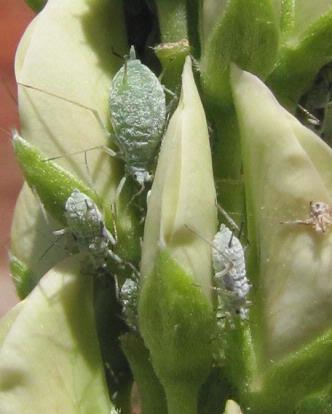When you think of aphids, you no doubt think of the alt-country band from Basel, Switzerland and their single “I don’t want to go to heaven” (because they’re closing all the bars). Perhaps you think of the Soviet era missile nicknamed “the aphid.” I don’t, because I’m more into the prog-rock band “the aphid” from Maine. But recently I noticed that my volunteer lupin planting looked a little wilty. Upon further investigation it became clear that I had an infestation of aphids (not the band, the insect).
Aphid taxonomy is above my pay grade, but I’m willing to bet that what I have is Macrosiphum albifrons, the American lupin aphid. If I pause before mushing aphids, what strikes me is the astounding diversity in form. There are several small nymph forms that eventually grow into the corpulent adult form. These then grow wings to migrate to greener pastures when they feel crowded. As with many mosquitoes and bees the vast majority of individuals you see are the females.
Aphids do reproduce sexually, but many females can also give birth through parthenogenesis. That’s when an embryo develops into an adult without fertilization. These are clones of mom. It’s a good thing republicans can’t generate offspring this way, though this would explain the spread of the Tea Party.
Once aphids have laid waste to your plants, many will sprout wings and move on to greener pastures. According to a publication from Cornell’s extension service they can fly high and far: as high as 20,000 feet and over distances as much as 1000 miles (http://nysipm.cornell.edu/factsheets/vegetables/potato/gpa.pdf).
Aphids feed on the sugary phloem of plants. Essentially they steal the product of photosynthesis. That’s sort of like what we do with plants. Aphids, like us, also tend to kill their host leaving a wilted dead plant when they move on. The sugary phloem of plants tastes great, but it’s not a balanced diet, despite what my indigent boarders tell me about syrup. To handle this aphids have evolved a symbiotic relationship with a bacterium called Buchnera aphidicola these guys live inside some of the aphid’s cells and produce amino acids so that the aphid can make protein. Pretty clever.
That’s all well and fine Mr. Bloviator, but what do I do about them? When I have an infestation in the garden I do a few things. I hit the aphids with dilute dish detergent (2%). This must be done repeatedly because they’ll come back. I then plant a trap crop like nasturtiums. Aphids love nasturtiums in my experience. Unfortunately, they also love lupins so I will probably just pretend my lupins are weeds and allow this to go on: as long as they don’t attract the funk metal band from Twickenham, UK known as “aphid.”
When you think of aphids, you no doubt think of the alt-country band from Basel, Switzerland and their single “I don’t want to go to heaven” (because they’re closing all the bars). I don’t, because I’m more into the prog-rock band “the aphid” from Maine. But recently I noticed that my volunteer lupin planting looked a little wilty. Upon further investigation it became clear that I had an infestation of aphids (not the band, the insect).
Aphid taxonomy is above my pay grade, but I’m willing to bet that what I have is Macrosiphum albifrons, the American lupin aphid.

If I pause before mushing aphids, what strikes me is the astounding diversity in form. There are several small nymph forms that eventually grow into the corpulent adult form. These then grow wings to migrate to greener pastures when they feel crowded. As with many mosquitoes and bees the vast majority of individuals you see are the females.
Aphids do reproduce sexually, but many females can also give birth through parthenogenesis. That’s when an embryo develops into an adult without fertilization. These are clones of mom. It’s a good thing republicans can’t generate offspring this way, though this would explain the spread of the Tea Party.
Once aphids have laid waste to your plants, many will sprout wings and move on to greener pastures. According to a publication from Cornell’s extension service they can fly high and far: as high as 20,000 feet and over distances as much as 1000 miles (http://nysipm.cornell.edu/factsheets/vegetables/potato/gpa.pdf).
Aphids feed on the sugary phloem of plants. Essentially they steal the product of photosynthesis. That’s sort of like what we do with plants. Aphids, like us, also tend to kill their host leaving a wilted dead plant when they move on. The sugary phloem of plants tastes great, but it’s not a balanced diet, despite what my indigent boarders tell me about syrup. To handle this aphids have evolved a symbiotic relationship with a bacterium called Buchnera aphidicola these guys live inside some of the aphid’s cells and produce amino acids so that the aphid can make protein. Pretty clever.
That’s all well and fine Mr. Bloviator, but what do I do about them? When I have an infestation in the garden I do a few things. I hit the aphids with dilute dish detergent (2%). This must be done repeatedly because they’ll come back. I then plant a trap crop like nasturtiums. Aphids love nasturtiums in my experience. Unfortunately, they also love lupins and my lupins don’t really feed me, so I will probably just pretend my lupins are weeds and allow this to go on: as long as they don’t attract the funk metal band from Twickenham, UK known as “aphid.”



